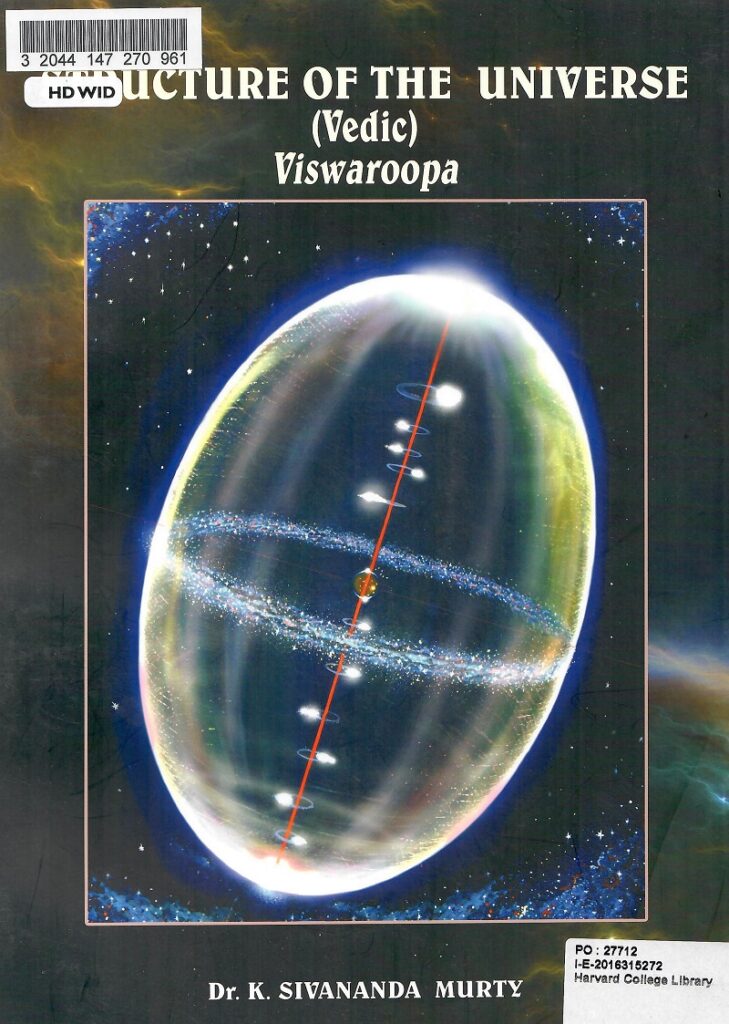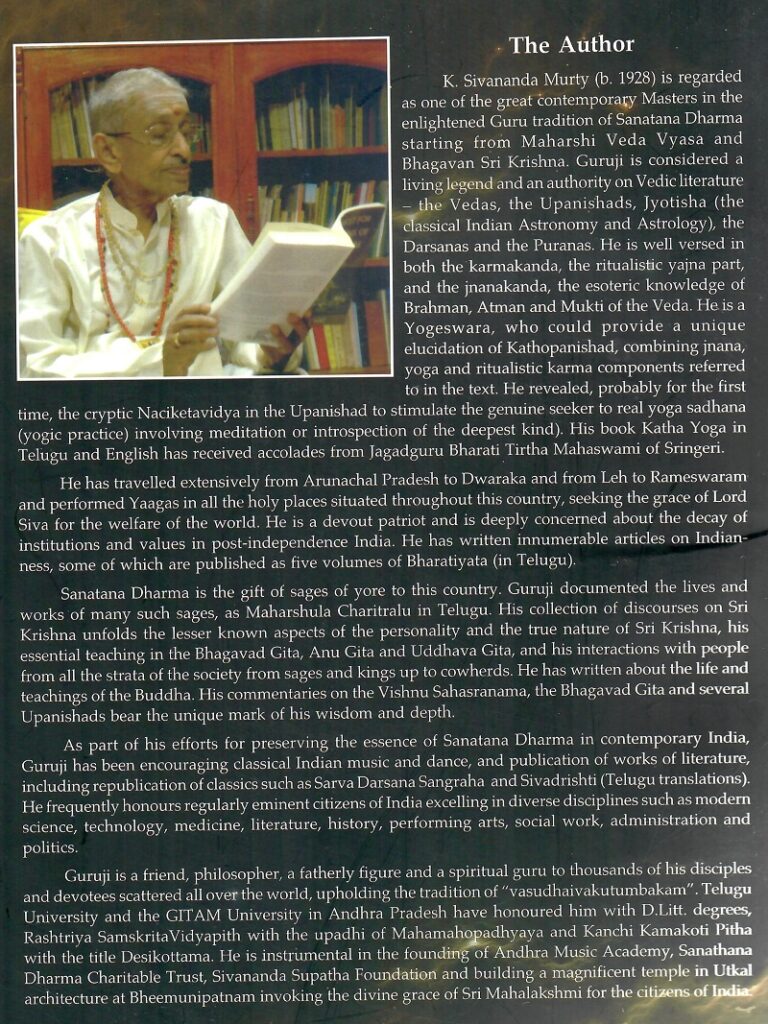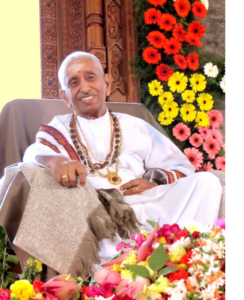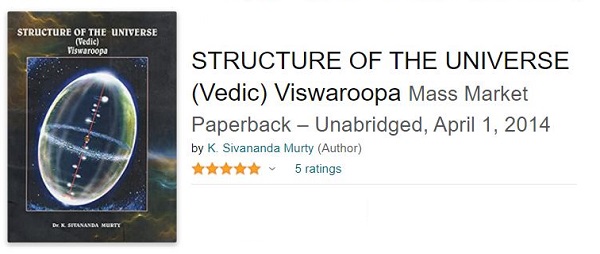
Structure of the Universe
(Vedic)
Viswaroopa
Mahamahopadhyaya, Desikottama
Dr. K. Sivananda Murty
Anandavan, Bheemunipatnam
2014

Prologue
Astronomy and cosmology in India, like many other sciences of human interest, have their roots in the Vedic literature, comprising the Vedas, Vedangas, Srouta sutras, Grhya sutras, Smrtis and Puranas and the glosses on some of them. Though valuable data pertaining to these sciences are found scattered in the vast Vedic literature, no concerted effort appears to have been made to codify the whole data into independent units in a systematic manner for many centuries, because these sciences also are considered as the auxiliaries to the ritualistic or philosophic teachings contained in the Vedic literature.
Western scholars, on the other hand, like Aristotle and Ptolemy and their successors have treated them as subjects requiring special pursuit and produced independent treatises on them. No doubt, independent works on these sciences of India have appeared in later times, but they did not attract the attention of the Western scholars who, in the early years of their contact with Indian Literature, were acquainted only with the Vedic literature. That is the reason why Western or American scientists did not give any important place to Indian Astronomy and cosmology, though they have their own uniqueness. Moreover, the deliberate attempt on the part of the earlier Western scholars to maintain that all the so called achievements of India, which was under the colonial rule for a long time, in fields like art, architecture, literary forms like drama sciences and even philosophy are the result of free borrowing from Greece and some Arabic countries, continues to have its own effect on the thinking not only of the modern scholars of the West but also of Indian scholars who have been trained to despise everything Indian as of secondary importance.
In this present work of nine chapters, entitled The Structure of the Universe by Paramapujya Sadguru Sri Sivananda Murty garu, a succinct account of the unique achievements of India in the field of cosmology and Astronomy is given, following a systematic method of comparing the early Indian theories with those of the Western and American scholars, both ancient and modern. This valuable work of Sadguruji is the outcome of a very long indepth study of the subjects coupled with the yogic perception (yoga Pratyaksa); thus it is on the lines of works of the ancient Indian Rishis.
In the first Chapter, after a brief survey of the cosmological theories of the Western scholars, which were mainly based on physics, it is shown how Vedic culture which gives great importance to yajna and the ultimate human goal salvation is totally distinct and accordingly how the cosmological and astronomical theories are developed in India. As many of the observations and conclusions of even modem scientists are mainly dependent on postulates which are always bound to be changed or even discarded, it is pointed out that it is not possible to apply many of the laws and principles to the imaginary worlds outside the galaxy. This is the reason why the Rsis in India were not bothered to talk about such worlds.
Some of the principles are not applicable even in the Swargaloka which is believed to be part of Brahmanda. There is a vedic statement “Uttana vai devagava vahanti”

meaning “the divine cows walk in a topsy turvy position”. What exactly it implies is very difficult to know. Does it indicate the principles of gravitational pull are entirely different in that Loka, or that it simply floats on one of the seven airs described in Puranas etc?

Truth cannot be realized by mere observation; Meditation is the most required sadhana for its realization and experience. “Therefore any amount of progress in science in the subject of cosmology cannot make meditation redundant since such investigation makes no attempts to reveal the secret spirit of creation of the self within”, declares Sadguruji, thereby indicating the perfectness of cosmological truths arrived by Rishis of India. Therefore the account of creation given in Puranas and Epics cannot be brushed aside as mere utterances without proper authority.
In the second chapter entitled “The Structure of the Universe”, there is a very highly scholarly discussion comparing and contrasting the theories contained in the Indian literature like the Brahmanda Puranas and Srimadbhagavata on one hand and the theories developed by modem scientists.
Aryabhata, the great Astronomer of the 5th century C.E, hailing from Kerala, has established in his work Aryabhatiyam that the earth moves with certain speed and that the dwellers on the earth feel, that the Bhagana, the group of stars and the planets are moving in opposite direction, just as a man travelling by a moving boat sees the trees on the banks of the river moving in opposite direction.

At the same time, he maintains that all the planets including the Sun have their own movement. According to him the Sun makes 4,320,000 bhramanas (rotations) in a Mahayuga.
In the Bhisma parva of Mahabharata, there is an elaborate description of Bhugola with its seven Dvipas, big continents, in nine Adhyayas (4th to 12th Adhyayas) with a detailed description of the people, flora and fauna of all the Dvipas. A large portion of the 5th skandha of Srimadbhagavata is devoted to the description of the Bhugola.
There is a vivid description of the creation and the cause and purpose in Indian literature, especially in Vedanta. All these points which are unique in Indian scientific thinking are discussed in the 2nd chapter.
The goal of human existence, the evolution of souls, the creation, maintenance and dissolution of the Universe and many other subjects like the nature and functions of the Trinity, form the subject matter of the 3rd chapter.
In the 4th chapter which is the crest jewel of the whole work, many of the unique featu-es of the Indian Astronomy and Astrology are explained. The concept of Yuga, Manvantara and Kalpa involving hundreds of thousands of years is not found in the sciences of any other country which is but natural because all the Western countries believe that the Universe is just six thousand years old.
Under the sub-heading; ‘Galaxy Vs. Brahmanda’ it is said that like the volume of the galaxy which expands and contracts, Brahmanda also has a property of expanding up to a limit and then contracting and finally to collapse. This is known as Srusthi, Sthiti and Laya.
Referring to the allegations that the Indian Astrologers had deliberately introduced the theory of libration into the science of Astronomy, Sadguruji says : “it cannot be a motivated creation of Astrologers as accused by some,” “introduction of libration does not benefit the science of Astrology in any manner since it is a long time phenomenon, and also not relevant to human horoscope.”
Sadguru Sri Sivananda Murty Ji, is a great savant who has taken preserving and propagation of Indian Culture in its various aspects as his life’s mission by adopting every possible method like writing books, backed by scriptural authority on various subjects, conducting national and international seminars, establishing cultural organizations and periodically honouring eminent personalities who won laurels in different fields, selected from all parts of India.
I feel very much honoured for having been asked by Sadguruji to write a few words on this great work, which as mentioned earlier is the product of long study and Yogic perception.

Sadguru Sri Sivananda Murty Garu is one of the greatest Spiritual Masters of our times.

Sri Kandukuri Sivananda Murty garu was born on 21st December 1928 at Rajahmundry, Andhra Pradesh. His father Late Sri Kandukuri Veera Basavaraju garu was the last Zamindar of Urlam Estate of Srikakulam District, a Zamindari of Madras presidency. The family was well-known for the generous support extended to the scholars in the study of the Vedas, Sastras, Fine Arts etc. and also supported India’s freedom movement. Sri Sivananda Murty garu studied at Maharaja’s College of Vijayanagaram during the years 1947–49 and obtained B.Sc. degree from Andhra University. Later he opted for a sub-ordinate service in the region of Telangana to understand the ground realities and problems faced by the poor. He has rendered free medical help (Homoeopathy) to thousands of patients. He retired voluntarily, five years prior to superannuation, as Secretary, Personnel & Planning (Administration) to the DGP.
As an individual his contribution to the society is unique, outstanding and multifaceted. With his background of voracious reading of more than 13000 books before his 33rd year itself in various subjects ranging from Telugu & Sanskrit Literature, Indology, Astrology, Astronomy, History, Religion, Spirituality, Science, Medicine etc, he could offer clarifications and guidance to many. His love for books is such that he has housed his personal collection of nearly 16000 books in a separate Library attached to his residence in Bheemli. An outstanding patriot, he extensively toured Bharat throughout its length and breadth, and studied it’s people and society, interacted with people of various walks of life, from commoners to intellectuals and leaders. During his lifetime, he has undertaken innumerable charitable activities. A team of committed self-less individuals and friends under his guidance, have performed more than 600 Rudra Yagnas all over the country with the Sankalpa of obtaining Divine Grace for the safety of our country and preservation of our ancient culture. His special concern for the well-being of the tribal population had taken him to remote areas in Arunachal Pradesh, Gujarat, Chattisgarh etc, where medical camps and other welfare activities were initiated for people, especially for the children. He also travelled to various countries and has many friends and admirers worldwide.
Writings, Scholarship, Foundation, other Activities
Sadguru is not only a voracious reader, but also a prolific writer and a versatile speaker. He had contributed more than 400 articles in Telugu dailies like Andhra Bhoomi and to `Supatha’, a monthly Cultural magazine, he published various souvenirs to educate and inspire the society towards righteous living, patriotism, ancient culture and heritage. He has given several talks on AIR and TV channels on Bhakti, Culture and Patriotism for over three decades. He had delivered lectures on Upanishads, Srimad BhagavadGeetha, Siva Yoga and on Spirituality, Religion and Ancient systems of Yoga etc, his talks are extensive and are spread-over thousands of pages. He has contributed forewords to innumerable books written in English and Telugu on various subjects. He was awarded Doctor of Letters (D. Litt) Degree, in recognition of his eminence in the year 2005 by Potti Sriramulu Telugu University, Hyderabad, GITAM University, Visakhapatnam in 2010, Mahopadhyaya from Rashtriya Vidya Peetha, Tirupati and Desikothama by Sri Kanchi-Kamakoti Peetham, Kanchi in 2011.
Sadguru was awarded the prestigious `Chandrasekharendra Saraswathi Eminence Award’ by South Indian Education Society in Mumbai in 2007. Raja -Lakshmi Foundation presented their Annual Award to him in Chennai in 2000. He was the Chief Pontiff of Saiva Maha Peetham of Andhra Pradesh for over a decade, as well as Chief Patron and Chairman of the Uttarandhra Veda Vidya Parishad.
Pujya Sadguru established Sri Mahalakshmi Temple & Charitable Trust to administer the temple related activities in Bheemunipatnam/Bheemili. Adyadi Sri Mahalakshmi temple was constructed by him and the temple was consecrated on Vijayadasami 9th October2008 by His Holiness Sri Sri Sri Jayendra Saraswathi Swami at Bheemili. Sarvajagathsakshi Ganapathi and Yoga Ganapathi temples were also constructed and consecrated by Pujya Guruji. A Dhyanamandiram, adjacent to the Mahalakshmi temple, has a giant deity of Dhanyalakshmi (5 Feet 4 Inches, Wt. 400 Kgs)brought from Indonesia. The deity Sri Dakshinamurthy is also consecrated, and a Yagna Sala was also constructed in the temple premises. .
Sadguru’s spiritual path is yoga and his way of life is humanistic patriotism. His commentary on Kathopanishad is published as ‘Kattha Yoga’, which is an in-depth yogic interpretation of the text and is highly relevant to the sadhaks. This commentary received an authoritative Srimukham from H.H Bharati Teertha Mahaswami of Sringeri Peetham and is highly appreciated by the learned scholars of Vedanta. He has also authored Life histories of our great sages `Maharshula Charitra’ published in two volumes in Telugu. He established Andhra Music Academy to spread the rich culture and heritage in the fields of Classical Music and Dance, and eminent personalities are honoured with `Sangeetha Vidya Nidhi’ and `Natya Vidya Nidhi’ titles during the Annual Music Festivals, which also had A-V exhibitions covering history, culture and arts. Sadguru set up a recording studio in Bheemili to render free support to the artists, many audio CDs have been released and regular music concerts were held. Outstanding personalities from various walks of life are honoured on Sri Ramanavami and Sri Krishna Janmashtami. The film `Gautama Buddha’ scripted by him won the special jury Nandi Award of Andhra Pradesh Govt for the year 2007. A TV serial `Mana katha’ (the story of Andhras from pre-historic times) also scripted by him won the Nandi Award. A 13-episode serial Anantha Kaalachakram (the story of cosmos from the early stages of creation) was also scripted by him and produced by SVBC.
Sadguru is the Founder and the source of inspiration and guidance to the Sanathana Dharma Charitable Trust which has been conducting a variety of activities to preserve and spread our ancient culture and heritage. Eminent Citizens are given `Sivananda Eminent Citizen Award’ and `Gangadevi Eminent Citizen Award’, annually for their outstanding contribution to the society, for over two decades.
Pujya Sadguru Dr. Sivananda Murty, one of the greatest exponents of Sanatana Dharma of our times, established the Sivananda Supatha Foundation (SSF) in 2012, with the objectives of ArshaVignanaseva, VidyaSeva, Vaidya seva, Karavalambana, Goseva. Sivananda Supatha Foundation has been focusing on carrying out work as per Guruji’s guidance. The foundation strives to disseminate the knowledge of Sanathana Dharma and ArshaVignana through print and electronic media. SSF is also providing free education, medical facilities and financial assistance for the rural people and underprivileged classes in our society. SSF works towards protecting cows and bovine cattle from premature death and neglect. He has renovated old temples and constructed new temples at many places. He built Community halls for the poor, renovated Government school and college buildings, provided new classrooms and labs with required furniture and equipment. He had also renovated heritage Police Station in Bheemunipatnam which dates back to British times.
With his inspiration, many cultural and social organizations took up social work and went on to serve classical learning and fine arts. He inspired youth to take up social work and contribute to Indian culture, and was instrumental in founding the I-FOCUS for guiding the youth. He was a great source of strength and inspiration to many important personalities in politics, administration, culture and literature. Indian and Western scholars in Indology, Yoga, Vedas, Vedanta and Jyotisha sought his guidance. He had intensely and constantly prayed for the protection and well-being of Bharat, especially eradication of poverty, protection of women and ethical politics. His followers and well-wishers always felt peace and solace in his presence, and sought guidance from him.
Pujya Sadguru left his mortal body and attained Sadgathi in 2015.
